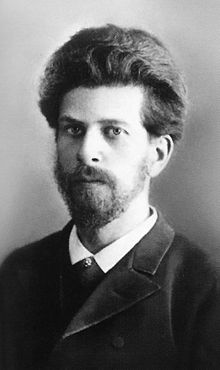Roman Klein
| Roman Ivanovich (Robert Julius) Klein | |
|---|---|

Roman Klein 1890
|
|
| Born |
March 31, 1858 Moscow, Russian Empire |
| Died | May 3, 1924 (aged 66) Moscow, Soviet Union |
| Nationality |
Russian Empire Soviet Union |
| Occupation | Architect |
| Practice | own practice |
| Buildings |
Pushkin Museum Middle Trading Rows Moore and Merilise Stores |
| Projects | Shelaputin Schools in Moscow |
Roman Ivanovich Klein (Russian: Роман Иванович Клейн), born Robert Julius Klein, was a Russian architect and educator, best known for his Neoclassical Pushkin Museum in Moscow. Klein, an eclectic, was one of the most prolific architects of his period, second only to Fyodor Schechtel. In the 1880s-1890s, he practiced Russian Revival and Neo-Gothic exteriors; in the 1900s, his knowledge of Roman and Byzantine classical architecture allowed him to integrate into the Neoclassical revival trend of that period.
Roman Klein was born in Moscow into a German merchant family of Ivan Makarovich Klein. He trained at the Moscow School of Painting, Sculpture and Architecture (1873–1874), with Vladimir Sherwood on the construction site of State Historical Museum (1875–1877), and at the Imperial Academy of Arts (1877–1882), winning a study tour to Italy and France (1883–1884), where he assisted Charles Garnier in preparation to the Exposition Universelle (1889). Klein returned to Moscow in 1885, worked as junior architect at local firms and went independent in 1888.
Most of Klein's professional career revolved around the 16-year Pushkin Museum project. The public contest of 1896, managed by Moscow State University, awarded first prize to Pyotr Boytsov; Klein used Boytsov's general layout but the exterior and interior styling is Klein's own, undisputed work. His knowledge of Greek and Byzantine classics was evident, however, the University also wanted perfection in other historical interiors (Egyptian, Babylonian) and sent Klein on two overseas study tours (1897, 1899–1900). Klein had studied the latest forms of museum construction in Europe, and he built a temple to the arts that expressed civic pride and private patronage, thus pleasing his benefactor, Nechaev-Maltsov, and creating what Lukomskii would have called approvingly a "European" building, noticeably different from the public and commercial buildings whose neoclassicism derived from the local Empire style. Klein employed Vladimir Shukhov for structural engineering of ceilings and sunroofs, Ivan Rerberg and other younger architects. The museum was generally complete by 1907; finishing works and expansions lasted to 1912.
...
Wikipedia
